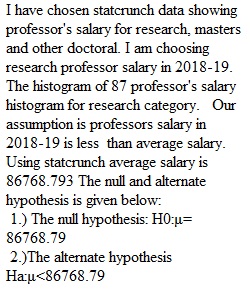


Q Evaluate In Module 6, you calculated confidence intervals from data and discussed your results. This time, you will do a hypothesis test and discuss the results. Do one of the following two options: (1) Collect 50 or more qualitative data items. Use the same method of collecting 50 or more data items that you used in the Module 1 discussion. You may use the same data you used in Module 6. You will first construct an appropriate set of hypotheses, H0 and H1, regarding your data. This might involve doing research regarding your data beforehand to figure out a meaningful set of hypotheses. View an example on how to use StatCrunch (with data) to do hypotheses tests for a population proportion. For your initial post, be sure to: • Briefly describe your data set • Include your Statcrunch report, either as an attachment or (even better) paste is into your discussion post Then, answer the following five parts: 1. Write down the null hypothesis. 2. Write down the alternative hypothesis. 3. Explain why you chose your hypotheses as such. 4. Do a hypothesist test of your data at the ? = 2% level of significance for the population proportion by carrying out the following five steps: i. View an example of how to use StatCrunch to compute the value Z? If it is a left-tailed test, what is the critical value, -z0.02? If it is a right-tailed test, what is the critical value, z0.02? If it is a two-tailed test, what are the two critical values, ±z0.01? ii. Write down the test statistic, z0. iii. Write down the P-value. iv. Write down the sample size. v. Write down the sample proportion. vi. Use the classical method to reach your conclusion on whether to reject or fail to reject the null hypothesis. Be sure to explain how you reached your conclusion. vii. Use the P-value to reach your conclusion on whether to reject or fail to reject the null hypothesis. Be sure to explain how you reached your conclusion. 5. Does the conclusion make sense to you? why or why not? OR (2) Collect 50 or more quantitative data items. Use the same method of collecting 50 or more data items that you used in the Module 1 discussion. You may even use the same data you used in Modules 1, 2, or 6. You will first construct an appropriate set of hypotheses, H0 and H1, regarding your data. This might involve doing research regarding your data beforehand to figure out a meaningful set of hypotheses. View an example on how to use StatCrunch (with data) to do hypotheses tests for a population mean. For your initial post, be sure to: • Briefly describe your data set • Include your Statcrunch report, either as an attachment or (even better) paste is into your discussion post Then, answer the following five parts: 1. Write down the null hypothesis. 2. Write down the alternative hypothesis. 3. Explain why you chose your hypotheses as such. 4. Do a hypothesis test of your data at the ? = 2% level of significance for the population mean by carrying out the following six steps: i. Write down the degrees of freedom, n-1. ii. View an example on how to use StatCrunch to compute the value t? If it is left-tailed test, what is the critical value, -t0.02? If it is right-tailed test, what is the critical value, t0.02? If it is two-tailed test, what are the two critical values, ±t0.01? iii. Write down the test statistic, t0. iv. Write down the P-value. v. Write down the sample size. vi. Write down the sample mean and sample standard deviation. vii. Use the classical method to reach your conclusion on whether to reject or fail to reject the null hypothesis. Be sure to explain how you reached your conclusion. viii. Use the P-value to reach your conclusion on whether or not to reject or fail to reject the null hypothesis. Be sure to explain how you reached your conclusion. 5. Does the conclusion make sense to you? Why, or why not? Assume that the hypothesis test methods mentioned in the textbook apply to your data. Make sure it is large enough (50 items or more). Please be sure to follow your primary posting with at least two substantive reply posts to your peers. In your response to classmates, you may discuss one of the following: a. Ask your classmate a question about his/her result that is not clear to you. b. Share something that you see about your classmate’s results that your classmate did not mention. You may also discuss specific details about the type of data. For example, if the hypothesis test is about weights of adults, when you may discuss unique details related to this type of data. c. Share what you have learned from your classmate’s results. ________________________________________ Your initial post is due by Thursday at 11:59 PM ET. Your responses are due by Sunday at 11:59 PM ET. Consult the Discussion Posting Guide for information about writing your discussion posts. It is recommended that you write your post in a document first. Check your work and correct any spelling or grammatical errors. When you are ready to make your initial post, click on "Reply." Then copy/paste the text into the message field, and click “Post Reply.” This is a “post first” discussion forum. You must submit your initial post before you can view other students’ posts. To respond to a peer, click “Reply” beneath her or his post and continue as with an initial post. ________________________________________ Evaluation This discussion will be graded using the discussion board rubric. Please review this rubric, located on the Rubrics page within the Course Introduction module of the course, prior to beginning your work to ensure your participation meets the criteria in place for this discussion. All discussions combined are worth 20% of your final course grade.
View Related Questions